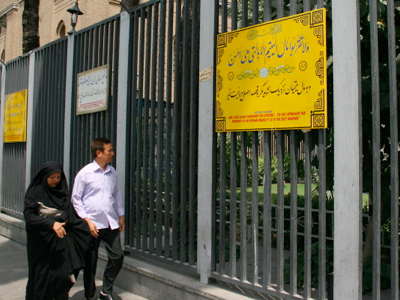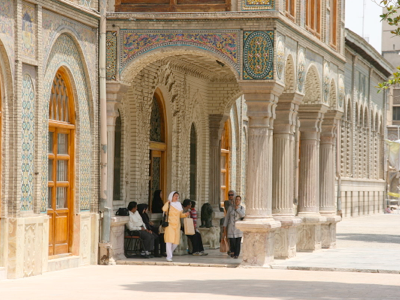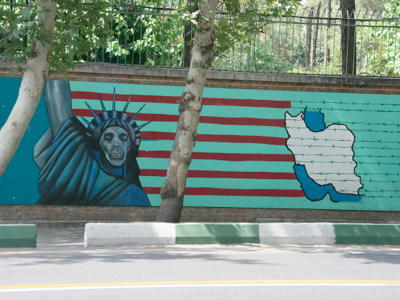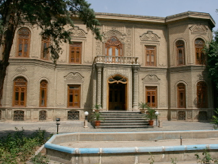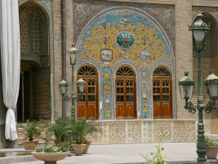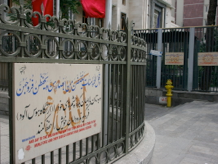North Africa ‘Plus’ Travel Diary

2011
Turkey Tunisia Algeria Iran Transnistria
Our first daytime look at Tehran this morning revealed a city with an elusive charm.
Maybe it was just that we had only had three and a half hours sleep. Or maybe it was the endless sea of rectangular, colourless, characterless, concrete block-like high-rise buildings that spread off into the dust haze. At first glance, Tehran did not like as though it was going to be Iran’s number one sightseeing drawcard.
Breakfast did little more to cheer us us, although to be fair, we did arrive just ten minutes before the sign indicated that they would finish serving breakfast. The reality was that I think they stopped serving it three hours earlier - or if the appearance of some of the food was any indication, perhaps three decades earlier. At least the carrot and sour cherry jam added some flavour to the hard blocks of off-white pumice-like material that were, apparently, being served as “bread”.
No, despite the comments above, I was not really in a crabby mood, but I could have done with more sleep and an edible breakfast before setting out for a day’s exploring in mid-thirties heat. Fortunately, and unfortunately, today was a religious holiday in Iran, meaning that (fortunately) the traffic volume and noise were much less than normal, but that (unfortunately) Tehran’s colourful and historic bazaar was closed.
It fascinates me that so many people think drivers in Tehran are bad. When you realise how few crashes there are despite the erratic, manic actions of the drivers, you start to appreciate their true skills. To cope with U-turns across four lanes of traffic across a median strip, to cope with cars doing blind high speed reversals up the wrong way of one way streets, to take as short cut around a traffic jam by driving on the footpath without killing of the hundreds of pedestrians in the way, and to negotiate the entire transect of this city of 15 million people without ever using brakes, these drives MUST be good!
Our “driver cum guide”, Kian, was keen to show us some of Tehran’s museums as a way to provide us with some background history to the places we would be seeing in Iran during the coming week. Our first stop was the National Museum of Iran, although the interest began even before entering as we walked past dozens of signs on the walls and fences beside the street with quotes from the Qu’ran. It was clear that the government takes the official national title of the “Islamic Republic of Iran” very seriously even if many of the folk with whom we spoke expressed more than a small degree of cynicism.
The Museum showed artifacts from Iran’s pre-Islamic history, which meant up until about 1400 years ago. Although the presentation of the exhibits was somewhat static, it did provide an excellent historical overview of Iran’s complex and very long history, something about which I knew far too little before my visit. Unfortunately, photographs were not permitted inside.
Our second stop was an architectural gem that was hiding from street view behind high fences. Just a short walk south from the National Museum and Imam Khomeini Square, the Golestan Palace complex was evidence of the perhaps excessive opulence of Iran’s Qajar rulers who controlled the country between 1848 and the early 1900s.
Various palace rooms were open to the public, some showing portraits, some photographs and so on, but by far the most extravagant was the mirrored coronation palace, where the lighting and the use of small cut mirrors to cover the walls and ceilings created what i thought was a celestial, almost other-worldly environment. It was in one of these sumptuous rooms that Churchill, Stalin and Roosevelt met towards the end of World War II to divide the post-war European continent. Unfortunately, photographs were not permitted inside.
A short drive northwards brought us to our next stop, the Glass and Ceramics Museum. Outshining the interesting collection of glassware was the beautiful Qajar-era building in which it was housed. Built as a private residence for a prominent Persian family, the building later housed the Egyptian embassy before being converted into a museum in 1976. Unfortunately, photographs were not permitted inside.
The day was getting on, and we had to get to Tehran’s Mehrabad Airport by 4:30 to check in for our flight to Shiraz. And so we drove without stopping past one of Tehran’s more intriguing locations, the US Den of Espionage. Housed in the former US Embassy, the US Den of Espionage is used by the Sepah militia, a hardline group dedicated to defending Iran’s Islamic revolution. It was interesting to see that the walls around the compound had recently been renovated, and the banners that I saw five years ago proclaiming “Death to Israel” had now been replaced by murals with anti-US slogans (in Farsi and English), illustrated in places with skeleton-like Statues of Liberty appearing to scream out in horror. Some of the local people I spoke with expressed embarrassment about the wall, one saying that “Iranians love Americans”. I guess it shows that diversity of opinion is alive and well in the Islamic Republic of Iran.
Before Tehran became the megalopolis that it is today, it comprised a rough collection of 140 villages, mainly involved in farming activities. A few of these villages still exist, and we drove through one of these (Kia) on our way to the airport. It was fascinating to see that within Tehran’s conurbation these small pockets of low rise housing interspersed with orchards and crop cultivation still exist.
Amazingly, according to local people with whom I spoke, our Iran Air flight from Tehran to Shiraz was on time. Miraculously, according to some recent statistics I have read about aviation safety in Iran, our flight landed safely. Actually, it was a good flight in a Dutch-built Fokker 100 (containing no US parts, and thus not subject to the trade embargo - well, no up-to-date US parts anyway). We were served a pleasant cold dinner of chicken on a bread roll with an interesting cake and fruit juice.
Upon arrival, we met our new “drive cum guide”, Mr Akbar Afkar, a delightful man with some great stories to tell, a deep wisdom and impeccable English, perhaps the legacy of his postgraduate studies in the US many years ago. Akbar will be with us for the rest of our time in Iran, which I regard as a true privilege.
We finally arrived at our hotel at a little after 8:30 pm. We are planning to get a good sleep to prepare for tomorrow’s sightseeing in temperatures that have been forecast to reach about 42 degrees.
In the shade.
If we can find any.

Day 18 - Tehran to Shiraz, Iran
Thursday
30 June 2011
Today’s Bonus Images








